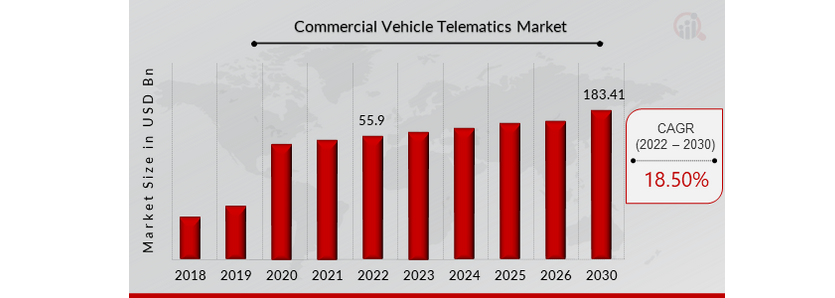Commercial vehicle telematics market to hit $183.41B by 2030

According to the new report from Market Research Future, “Commercial Vehicle Telematics telematics Size” was valued at USD 55.9 billion in 2022. The Commercial Vehicle Telematics industry is projected to grow from USD 66.24 Billion in 2023 to USD 183.41 billion by 2030, exhibiting a compound annual growth rate (CAGR) of 18.50% during the forecast period (2023 – 2030). Government policies for mandating commercial vehicle tracking and increasing safety and security regulations are the key market drivers enhancing market growth.
Commercial Vehicle Telematics refers to the use of GPS, sensors, and other technologies to track and monitor the performance, location, and behavior of commercial vehicles such as trucks, buses, and delivery vans. It provides valuable data and insights to fleet managers, helping them optimize their operations, reduce costs, and improve customer service. The COVID-19 pandemic has significantly impacted the commercial vehicle industry, leading to changes in demand, supply chains, and consumer behavior. The economic slowdown and the reduction in overall commercial vehicle usage have impacted the growth of the Commercial Vehicle Telematics market size.
Regional Analysis
The Commercial Vehicle Telematics market size expects to witness its highest growth in the Asia Pacific region due to factors such as the rapidly growing e-commerce industry, increasing government regulations mandating the use of telematics in commercial vehicles, and the large pool of potential customers in the region. Additionally, countries in the Asia Pacific region, such as China, India, and Japan, are heavily investing in developing smart cities and adopting new technologies. Analysts anticipate that this investment will drive the growth of the Commercial Vehicle Telematics market size in the region.
What is a vehicle telematic?
Vehicle telematics refers to the integration of telecommunications and informatics technologies in vehicles to collect, transmit, and receive data. This technology enables the remote monitoring and management of various aspects of a vehicle’s performance, location, and driver behavior. Telematics systems utilize a combination of hardware and software to gather and process data, providing valuable insights for both vehicle owners and fleet managers.
Here are some key components and functionalities of vehicle telematics:
- GPS Tracking: Telematics systems often include GPS (Global Positioning System) technology to track the real-time location of a vehicle. Moreover, this information can be used for navigation, route optimization, and monitoring the movement of vehicles within a fleet.
- Vehicle Diagnostics: Telematics devices are capable of collecting and transmitting data related to the health and performance of a vehicle. This can include information about engine diagnostics, fuel efficiency, tire pressure, and other critical parameters. The data helps in preventive maintenance and identifying potential issues before they become major problems.
- Driver Behavior Monitoring: Telematics systems can monitor and analyze driver behavior, including factors such as speed, acceleration, braking, and adherence to traffic rules. This data is valuable for promoting safer driving practices, improving fuel efficiency, and assessing driver performance.
- Communication and Connectivity: Telematics devices enable communication between vehicles and centralized systems. This connectivity allows for features such as remote vehicle diagnostics, over-the-air software updates, and real-time communication with drivers.
- Fleet Management: In the context of commercial or fleet vehicles, telematics is crucial for fleet management. It provides tools for tracking the location of all vehicles, optimizing routes, managing fuel consumption, and ensuring overall fleet efficiency.
Commercial Vehicle Telematics market size Technological Advancement:
The Commercial Vehicle Telematics market size has been rapidly advancing with technological advancements in recent years. Some of the key technological advancements in this market include:
- Connectivity technologies such as 4G LTE, 5G, and IoT that enable real-time monitoring and communication of vehicles.
- Advanced GPS systems with higher accuracy and reliability for vehicle tracking and fleet management.
- Big Data analytics tools and machine learning algorithms that enable better decision making and optimization of fleet operations.
- Development of cloud-based telematics solutions that provide scalable and cost-effective telematics services.
- These advancements have led to the creation of new and improved telematics services. These services and applications help commercial vehicle operators improve safety, efficiency, and profitability.
Market Segmentation
- The Global Commercial Vehicle Telematics market size has been segmented into type, provider type, and vertical.
- The market has segmented into Solutions and Services based on the type.
- Segmented the market into OEM and Aftermarket based on the provider type.
- Segmented the market into Transportation & Logistics, Government & Utilities, Travel & Tourism, Construction, Education, Healthcare, and Others based on the verticals.



